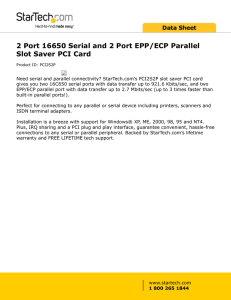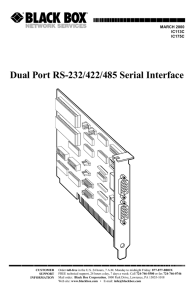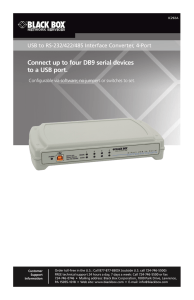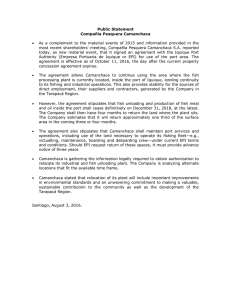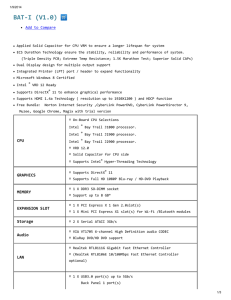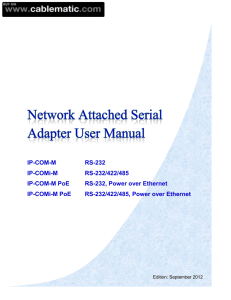Single Channel Parallel/Serial I/O Interface
Anuncio
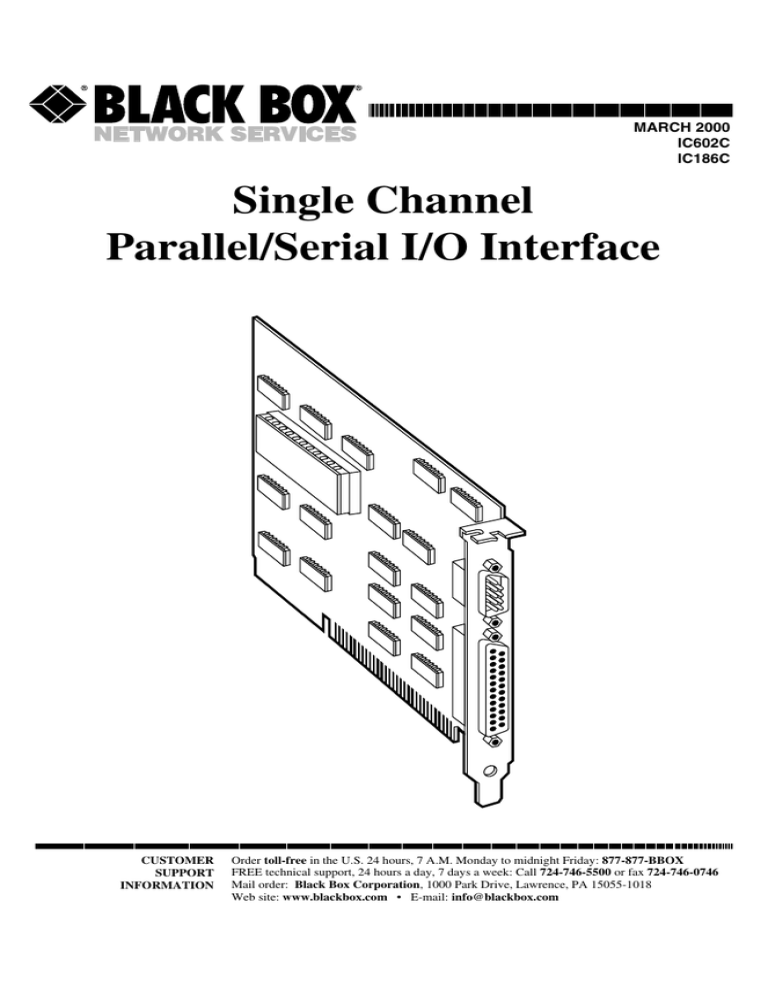
MARCH 2000 IC602C IC186C Single Channel Parallel/Serial I/O Interface CUSTOMER SUPPORT INFORMATION Order toll-free in the U.S. 24 hours, 7 A.M. Monday to midnight Friday: 877-877-BBOX FREE technical support, 24 hours a day, 7 days a week: Call 724-746-5500 or fax 724-746-0746 Mail order: Black Box Corporation, 1000 Park Drive, Lawrence, PA 15055-1018 Web site: www.blackbox.com • E-mail: [email protected] SINGLE CHANNEL PARALLEL/SERIAL I/O INTERFACE TRADEMARKS USED IN THIS MANUAL All applied-for and registered trademarks are the property of their respective owners. 2 FCC STATEMENT FEDERAL COMMUNICATIONS COMMISSION AND CANADIAN DEPARTMENT OF COMMUNICATIONS RADIO FREQUENCY INTERFERENCE STATEMENTS This equipment generates, uses, and can radiate radio frequency energy and if not installed and used properly, that is, in strict accordance with the manufacturer’s instructions, may cause interference to radio communication. It has been tested and found to comply with the limits for a Class A computing device in accordance with the specifications in Subpart J of Part 15 of FCC rules, which are designed to provide reasonable protection against such interference when the equipment is operated in a commercial environment. Operation of this equipment in a residential area is likely to cause interference, in which case the user at his own expense will be required to take whatever measures may be necessary to correct the interference. Changes or modifications not expressly approved by the party responsible for compliance could void the user’s authority to operate the equipment. This digital apparatus does not exceed the Class A limits for radio noise emission from digital apparatus set out in the Radio Interference Regulation of the Canadian Department of Communications. Le présent appareil numérique n’émet pas de bruits radioélectriques dépassant les limites applicables aux appareils numériques de classe A prescrites dans le Règlement sur le brouillage radioélectrique publié par le ministère des Communications du Canada. 3 SINGLE CHANNEL PARALLEL/SERIAL I/O INTERFACE NORMAS OFICIALES MEXICANAS (NOM) ELECTRICAL SAFETY STATEMENT INSTRUCCIONES DE SEGURIDAD 1. Todas las instrucciones de seguridad y operación deberán ser leídas antes de que el aparato eléctrico sea operado. 2. Las instrucciones de seguridad y operación deberán ser guardadas para referencia futura. 3. Todas las advertencias en el aparato eléctrico y en sus instrucciones de operación deben ser respetadas. 4. Todas las instrucciones de operación y uso deben ser seguidas. 5. El aparato eléctrico no deberá ser usado cerca del agua—por ejemplo, cerca de la tina de baño, lavabo, sótano mojado o cerca de una alberca, etc.. 6. El aparato eléctrico debe ser usado únicamente con carritos o pedestales que sean recomendados por el fabricante. 7. El aparato eléctrico debe ser montado a la pared o al techo sólo como sea recomendado por el fabricante. 8. Servicio—El usuario no debe intentar dar servicio al equipo eléctrico más allá a lo descrito en las instrucciones de operación. Todo otro servicio deberá ser referido a personal de servicio calificado. 9. El aparato eléctrico debe ser situado de tal manera que su posición no interfiera su uso. La colocación del aparato eléctrico sobre una cama, sofá, alfombra o superficie similar puede bloquea la ventilación, no se debe colocar en libreros o gabinetes que impidan el flujo de aire por los orificios de ventilación. 10. El equipo eléctrico deber ser situado fuera del alcance de fuentes de calor como radiadores, registros de calor, estufas u otros aparatos (incluyendo amplificadores) que producen calor. 4 NOM STATEMENT 11. El aparato eléctrico deberá ser connectado a una fuente de poder sólo del tipo descrito en el instructivo de operación, o como se indique en el aparato. 12. Precaución debe ser tomada de tal manera que la tierra fisica y la polarización del equipo no sea eliminada. 13. Los cables de la fuente de poder deben ser guiados de tal manera que no sean pisados ni pellizcados por objetos colocados sobre o contra ellos, poniendo particular atención a los contactos y receptáculos donde salen del aparato. 14. El equipo eléctrico debe ser limpiado únicamente de acuerdo a las recomendaciones del fabricante. 15. En caso de existir, una antena externa deberá ser localizada lejos de las lineas de energia. 16. El cable de corriente deberá ser desconectado del cuando el equipo no sea usado por un largo periodo de tiempo. 17. Cuidado debe ser tomado de tal manera que objectos liquidos no sean derramados sobre la cubierta u orificios de ventilación. 18. Servicio por personal calificado deberá ser provisto cuando: A: El cable de poder o el contacto ha sido dañado; u B: Objectos han caído o líquido ha sido derramado dentro del aparato; o C: El aparato ha sido expuesto a la lluvia; o D: El aparato parece no operar normalmente o muestra un cambio en su desempeño; o E: El aparato ha sido tirado o su cubierta ha sido dañada. 5 SINGLE CHANNEL PARALLEL/SERIAL I/O INTERFACE Table of Contents Chapter Page 1. Specifications...................................................................................................7 2. Introduction ....................................................................................................8 3. Serial Port Address/Option Selection .........................................................11 3.1 Address Selection.............................................................................11 3.2 Option Selection..............................................................................12 3.2.1 Port Enable/Disable..............................................................12 3.2.2 Interface Selection ................................................................12 3.2.3 E1 Jumper for RS-232 Interface Option ..............................13 3.2.4 RS-422 Interface Options......................................................13 3.2.5 RS-485 Interface Options......................................................14 4. Parallel Port Address/Option Selection ......................................................16 4.1 Address Selection.............................................................................16 4.2 Option Selection..............................................................................16 4.2.1 E4............................................................................................16 4.2.2 E3............................................................................................17 5. Installation .....................................................................................................18 Appendix. Block Diagram..................................................................................20 6 CHAPTER 1: Specifications 1. Specifications Speed IC602C: Up to 115.2 Kbps; IC186C: 460.8 kbps and higher; Maximum data rate is dependent on software, CPU, and cable length Protocol Asynchronous only Connectors (1) DB9 male [serial], (1) DB25 female [parallel] Communications Chip IC602C: 16550 UART; IC186C: 16950 UART System Requirements ISA Bus Diagnostics (Included) utility software Operating Temperature 32 to 122°F (0 to 50°C) Storage Temperature -4 to 158°F (-20 to 70°C) Relative Humidity 90%, noncondensing MTBF > 150,000 hours Power From PC bus Board Size 3 Shipping Weight 2 lb. (0.9 kg) ⁄4-size card 7 SINGLE CHANNEL PARALLEL/SERIAL I/O INTERFACE 2. Introduction The Single Channel Parallel/Serial I/O Interface provides two functions: A Centronics parallel port (DB25 female connector) and a serial port (DB9 male connector) that supports both RS-232 and RS-422/485. Serial port features include: • DB9 male connector mounted above the DB25 female printer connector on board bracket. • Port can be addressed as COM1: (3F8 Hex), COM2: (2F8 Hex), COM3: (3E8 Hex), or COM4: (2E8 Hex), or any other I/O address from 0 to 3FF Hex. • IRQs 3, 4, 5, 9, 10, 11, 12, and 15. • Interrupts can be shared with other sharable interrupts. • RS-232C interface with all standard PC signals (TD, RD, RTS, CTS, DSR, DCD, DTR, RI), or RS-422 interface with the TD, RD, RTS, CTS signals. • Serial port interface is determined by jumper selection. Parallel port features include: • IBM and Centronics compatible parallel-printer port. • User-selectable (via DIP switch) addresses of LPT1 through 3; any other I/O addresses are from 200 to 3FF Hex. • IRQs 3, 4, 5, 7, 10, 11, 12, and 15. • Interrupts can be shared with other sharable interrupts. • Provides a DB25 female connector with the Centronics parallel-printer pinout standard in the PC industry. • Jumper E (position B) is provided to allow the port to operate bidirectionally, as some PS/2 models do. 8 CHAPTER 2: Introduction The Single Channel Parallel/Serial I/O Interface board (IC602C) uses the same 16550 UART chip found in the IBM asynchronous adapter. This chip features programmable baud rate, data format, and interrupt control. Refer to the IBM Technical Reference for details on programming the chip. The serial port can be set as COM1: through COM4:, providing total compatibility with most communications software and languages. The IC186C uses the 16950 UART chip for even better performance. RS-232 or RS-422/485 drivers and receivers are on the serial port. RS-422 allows very-long-distance (5000 feet or 1524 m at 9600 baud) communications with virtually error-free differential-drive characteristics. RS-485 is backwardly compatible with RS-422, but is mainly used for partyline or multi-drop applications. The output of the RS-422/485 driver is capable of being active (ON) or tristate (OFF). This allows multiple PCs (or other RS-422/485 devices) to be connected in a multi-drop bus and selectively polled. Half-duplex two-wire operation is also possible by connecting TX+ to RX+ and TX- to RX- (in the connector hood). The driver can be enabled by the UART Request To Send (RTS) line or optionally tied high (permanently enabled) for four-wire operation only. To permanently enable the driver, move jumper position “E” on E1 to position “A.” Table 2-1. DB9 Connector Pinout, RS-232 Interface Signal Name TD RTS RD CTS GND DCD DSR DTR RI Transmit Data Request to Send Receive Data Clear to Send Ground Data Carrier Detect Data Set Ready Data Terminal Ready Ring Indicator Pin # 3 7 2 8 5 1 6 4 9 Mode Output RS-232 Output RS-232 Input RS-232 Input RS-232 Input RS-232 Input RS-232 Output RS-232 Input RS-232 9 SINGLE CHANNEL PARALLEL/SERIAL I/O INTERFACE Table 2-2. DB9 Connector Pinout, RS-422/485 Interface Signal Name GND RDB RDA CTSB CTSA TDB TDA RTSB RTSA Ground RX+ RXCTS+ CTSTX+ TXRTS+ RTS- Receive Positive Receive Negative Clear to Send Positive Clear to Send Negative Transmit Positive Transmit Negative Request To Send Positive Request To Send Negative Pin # Mode 5 1 2 9 8 4 3 6 7 Input RS-422 Input RS-422 Input RS-422 Input RS-422 Output RS-422 Output RS-422 Output RS-422 Output RS-422 Line Termination Typically, each end of the RS-422/485 bus must have line-terminating resistors. A 100-ohm resistor is across each RS-422/485 input and a 1-Kohm pull-up/pull-down combination bias the receiver inputs. If multiple (more than two) RS-485 nodes are configured in a multi-drop network, only the nodes at each end of the bus should have the 100-ohm resistors installed. If non-standard baud rates are required, such as 31.25 or 76.8 Kbps, location Y1 allows a different oscillator to be installed. Contact your supplier for more information. 10 CHAPTER 3: Serial Port Address/Option Selection 3. Serial Port Address/Option Selection 3.1 Address Selection The Serial Port on the Single Channel Parallel/Serial I/O Interface occupies 8 consecutive I/O locations. A DIP switch (SW2) is used to set the base address for these locations. Be careful when selecting the base address, since some selections conflict with existing PC ports. The following table shows several examples that usually do not cause a conflict. Address Binary A9 280-287 2A0-2A7 1A0-1A7 2F8-2FF 3F8-3FF 2E8-2EF 3E8-3EF 320-327 328-32F COM2: COM1: COM4: COM3: A0 1 10 1000 0XXX 10 1010 0XXX 01 1010 0XXX 10 1111 1XXX 11 1111 1XXX 10 1110 1XXX 11 1110 1XXX 11 0010 0XXX 11 0010 1XXX OFF OFF ON OFF OFF OFF OFF OFF OFF SW2 Switch Position Setting 2 3 4 5 6 ON ON OFF ON OFF ON OFF OFF OFF OFF OFF OFF OFF OFF OFF OFF ON ON ON ON ON OFF OFF OFF OFF ON ON ON OFF OFF OFF OFF OFF OFF OFF OFF ON ON ON OFF OFF ON ON ON ON 7 ON ON ON OFF OFF OFF OFF ON OFF If you don’t see an address in the table that’s compatible with your software, you can determine the switch setting for a particular address by using the table on the next page. This table shows the correlation between the DIPswitch setting and the address bits used to determine the base address. In this example, the address 300 Hex through 307 Hex is selected. 300 Hex equals 11 0000 0XXX in binary representation. 11 SINGLE CHANNEL PARALLEL/SERIAL I/O INTERFACE Address 300 Binary A9-----------A0 1 2 SW2 Switch Position 3 4 5 11 0000 0XXX OFF OFF ON ON ON 6 7 ON ON NOTE Setting the switch ON (or closed) corresponds to a “0” in the address, while leaving it OFF (or open) corresponds to a “1.” 3.2 Option Selection The board contains several jumper straps for each port which must be set for proper operation. For proper jumper location, refer to the block diagram in the Appendix. 3.2.1 PORT ENABLE/DISABLE The serial port on the Single Channel Parallel/Serial I/O Interface can be enabled or disabled with switch-position 8 on the DIP switch SW2. The port is enabled with the switch “ON” and disabled when “OFF” or “OPEN.” 3.2.2 INTERFACE SELECTION E2 connects the DB9 connector to either RS-232 interface circuits, or to the RS-422/485 interface circuits. The table below shows the settings. Interface Jumper Position RS-232 RS-422/485 E2 “RS-232” E2 “RS-422” Note that on E2 you must move all eight push-on jumpers. This will completely isolate RS-232 circuits from RS-422/485 circuits and vice versa. On E1, however, there are several jumper options. 12 CHAPTER 3: Serial Port Address/Option Selection 3.2.3 E1 JUMPER SETTING FOR RS-232 INTERFACE OPTION The “A” position is the normal (RS-232) position for all eight jumpers, assuming that the interface requires or uses, all of the modem control signals. Table 3-1. Jumper E1 (Set for RS-232) GND E CTS RI CD DSR CTS RD ο[οο] ο[οο] ο[οο] ο[οο] ο[οο] ο[οο] ο[οο] ο[οο] Ground Enable Ring Indicator Carrier Detect Data Set Ready Clear To Send Receive Data “A” selects normal ground for RS-232. “A” (not applicable to RS-232). “A” selects RS-232 receive data. “A” enables RI; “B” sets it true. “A” selects RS-232. “A” selects RS-232. “A” selects RS-232. “A” selects RS-232. B A 3.2.4 RS-422 INTERFACE OPTIONS E1 provides jumper options for RS-422. The normal position is “B” for all eight jumpers with the following exceptions: Table 3-2. Jumper E1 (Set for RS-422) GND E CTS [οο]ο ο[οο] ο[οο] Ground Enable RI CD DSR CTS RD [οο]ο [οο]ο [οο]ο [οο]ο [οο]ο B A Ring Indicator Carrier Detect Data Set Ready Clear To Send Receive Data “B” selects 100-ohm ground for RS-422. “A” for RS-422. “A” selects RS-422 CTS signal (“B” to set true). (not used on RS-422); “B” sets it true. “B” sets it true. “B” sets it true. “B” RS-422; remove if CTS set true. “B” selects RS-422. 13 SINGLE CHANNEL PARALLEL/SERIAL I/O INTERFACE 3.2.5 RS-485 INTERFACE OPTIONS E1 also provides jumper options for RS-485. The normal position is “B” for all eight jumpers with the following exceptions: Table 3-3. Jumper E1 (Set for RS-485) GND E CTS RI CD DSR CTS RD [οο]ο [οο]ο ο[οο] [οο]ο [οο]ο [οο]ο [οο]ο [οο]ο B A Ground RTS enable Ring Indicator Carrier Detect Data Set Ready Clear To Send Receive Data “B” selects 100-ohm ground for RS-485. “B” for RS-485. “A” selects RS-485 CTS signal (“B” to set true). (not used on RS-485); “B” sets it true. “B” sets it true. “B” sets it true. “B” RS-485; remove if CTS set true. “B” selects RS-485. E1 Position “E” determines determines whether the RS-485 driver is enabled by the UART signal Request To Send (RTS) or always enabled. With the jumper installed in position “B,” RTS enables the driver. Moving the jumper to position “A” enables the driver regardless of RTS. This jumper should only be set to “B” if you are running the board in a multi-drop polled environment such as RS-485, and you have software that knows how to “talk” on the RS-485 bus. For normal point-to-point RS-422 (such as terminal emulation), select jumper position “A.” Position “GND” determines whether the board provides a direct ground connection (as in RS-232 and most RS-422), or a 100-ohm high-impedance ground normally used in RS-485 (and some RS-422) to avoid ground-loop currents with long cables. E5 E5 selects the interrupt request for the serial port. If COM1: is selected, this jumper must be on the IRQ4 setting. If COM2: is selected, this jumper must be on IRQ3. Consult your particular software for IRQ selection. If no interrupt is desired, remove the jumper. IRQ 2/9 selects IRQ2 on XT 14 CHAPTER 3: Serial Port Address/Option Selection machines and IRQ9 on AT and 386 machines. Note that IRQ 10, 11, 12, and 15 are on the AT and 386 bus machines only. E5: ο ο ο ο ο ο ο ο ο ο ο ο ο ο 15 12 11 10 5 4 3 ο ο IRQ selection 2/9 (AT) Select only one E3 “M” and “N”—placing the jumper on “N” selects the normal (“N”) single interrupt per board mode. Placing the jumper on “M” selects the multiinterrupt (“M”) mode. The multi-interrupt mode allows you to share the IRQ signal(s) with other cards that support multiple interrupts. The “M” and “N” selections for the serial port are under “SP.” E3: PP SP PP ο ο ο ο ο ο ο ο ο ο ο ο B N M N M N Select one 15 SINGLE CHANNEL PARALLEL/SERIAL I/O INTERFACE 4. Parallel Port Address/Option Selection 4.1 Address Selection The parallel port on the Single Channel Parallel/Serial I/O Interface occupies three consecutive I/O locations. A DIP switch (SW1) is used to set the base address for these locations. Note that address line A9 is always a “1.” Address Binary A9---A8--------------A0 1 A8 278-27B LPT3: 1 378-37B LPT2: 1 3BC-3BF LPT1: 1 0 1 1 0111 10XX 0111 10XX 1011 11XX SW1 Switch Position Setting 2 3 4 5 6 7 A7 A6 A5 A4 A3 A2 ON OFF OFF ON ON OFF OFF OFF OFF OFF ON OFF OFF OFF OFF ON ON OFF OFF OFF OFF NOTE Setting the switch ON (or closed) corresponds to a “0” in the address, while leaving it OFF (or open) corresponds to a “1.” If you need to enable or disable the Parallel port, you’ll need to use switch SW1, position 8. ON enables the port on the card, and OFF disables it. 4.2 Option Selection 4.2.1 E4 E4 selects the interrupt request for the parallel port. If LPT1: is selected, this jumper must be on the IRQ7 setting. Consult your particular software for IRQ selection. If no interrupt is desired, remove the jumper. E4: ο ο ο ο ο ο ο ο ο ο ο ο ο ο ο ο 15 12 11 10 5 4 3 7 IRQ selection Select only one 16 CHAPTER 4: Parallel Port Address/Option Selection 4.2.2 E3 “M” and “N”—placing the jumper on “N” selects the normal (“N”) single interrupt per board mode. Placing the jumper on “M” selects the multiinterrupt (“M”) mode. The multi-interrupt mode allows you to share the IRQ signal(s) with other cards that support multiple interrupts. The “M” and “N” selections for the parallel port are under “PP.” E3: PP SP PP ο ο ο ο ο ο ο ο ο ο ο ο B N M N M N Select one Select one “B” and “N”—placing the jumper in the “N” normal setting configures the parallel port as an output-only normal PC printer port. Position “B” (for bidirectional) allows the port to be run bidirectionally with software control of the port’s input/output mode. With the “B” position selected, the following assembly-language software will toggle the input/output mode. A base address of 378 is assumed. To set input mode: MOV DX, 37AH IN AL, DX OR AL,20H OUT DX, AL ;Set DX to Point to Control Register ;Get Old Port Data ;Or in Bit D5 to Turn Output Port Off ;Output New Value To set output mode: MOV DX, 37AH IN AL, DX AND AL,DFH OUT DX, AL ;Set DX to Point to Control Register ;Get Old Port Data ;And in Bit D5 to Turn Output Port On ;Output New Value NOTE The port powers up Reset as a normal output printer port, even if jumper selection “B” is selected. 17 SINGLE CHANNEL PARALLEL/SERIAL I/O INTERFACE 5. Installation IIMPORTANT You MUST set up the operating system BEFORE you physically install the Card. 5.1 Software Installation If you are installing an ISA adapter in DOS, OS/2®, or QNX, please refer to the appropriate directory on one of the Serial Utilities Disks for instructions. 5.1.1 WINDOWS 3.1X Please refer to the /WINDOWS sub-directory on the Serial Utilities Diskette for help files and current information on the installation of the Card in this operating environment. 5.1.2 WINDOWS 95/98 USERS For the ISA card, run setup on disk two of the Serial Utilities Diskettes before installing the card. Make note of the resources that Windows assigns the adapter, and set the adapter to match those resources. Power down the computer and install the adapter as described in Section 5.2. If you wish to change any resources assigned to the adapter, refer to the help file installed in the Black Box folder in the Start, Programs menu. 5.1.3 WINDOWS NT For the ISA card, run setup on disk two of the Serial Utilities Diskettes before installing the card. After installing the software, refer to the help file that automatically comes up for installation instructions. 18 CHAPTER 5: Installation 5.2 Hardware Installation The Single Channel Parallel/Serial I/O Interface can be installed in any of the PC expansion slots except J8 on the original IBM XT and portable. To install the card: • Remove the PC case. • Remove the screw holding the blank metal slot cover. • Remove the blank metal slot cover. • Gently insert the board. • Replace the blank metal slot cover. • Replace the screw. • Replace the PC case. Installation is complete. 19 SINGLE CHANNEL PARALLEL/SERIAL I/O INTERFACE Appendix. Block Diagram 8250 C10 E3 SW2 SERIAL PP SP PP E4 B N M N M N U17 A2 E A9 U18 A3 E C10 15 12 11 10 5 4 3 7 A8 E5 74LS682 C23 P3 C11 74LS244 U13 74LS374 U15 74LS00 U16 P2 C25 74LS244 IRQ C24 P1 A31 74LS245 C26 C27 For in-depth schematic detail, call for technical support. 20 5 9 U14 U19 15 12 11 10 5 4 3 2/9 74LS682 E2 74LS04 C21 ON=0 U11 D1 R3 D2 74LS125 SW1 PARALLEL C12 R2 U12 U10 MC145406 74LS05 74LS174 C9 A U9 1 6 1 B U8 J1 DTR RTS TD RI DCD DSR CTS RD MC1489 RD C8 Y1 RP2 U4 1 14 RP1 C7 C4 CTS C28 A1 13 25 U7 RP3 RS-422 CTS RI DCD DSR 74LS04 C20 74LS04 74LS138 GND EN U3 U6 75174 C13 C14 C15 C16 C17 C18 C19 C3 U2 1 C2 U1 C22 C1 1 R1 C6 75173 RS-232 U5 C5 E1 © Copyright 2000. Black Box Corporation. All rights reserved. 1000 Park Drive • Lawrence, PA 15055-1018 • 724-746-5500 • Fax 724-746-0746
